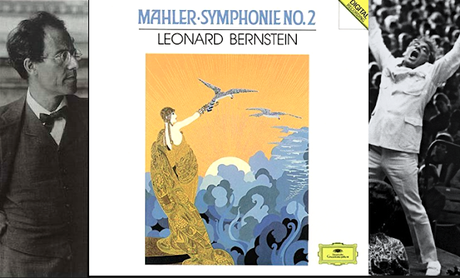by Paul J. Pelkonen
Part II of an ongoing series on Superconductor.

Gustav Mahler (left), Leonard Bernstein (right) and the cover art by Erte for the Mahler Symphony No. 2.
Images © Deutsche Grammophon, the estate of Erte, and the New York Philharmonic.
Bernstein chose to use the Concertgebouw (albeit in the drier acoustic of New York's Avery Fisher Hall) for this symphony, recording about a month before their First. Mahler's Resurrection was originally conceived as a direct sequel to his First. It was originally conceived a single-movement tone poem called Totenfier ("funeral rite"), depicting the honors for the heroic protagonist of the earlier symphony. By the time Mahler had finished the work, it had ballooned into five movements, and become the first of the composer's symphonies to incorporate vocal soloists and a chorus.
The first movement is the aforementioned Totenfier, taken here at a very slow trudge. One senses Bernstein trying to stretch and wring all of the emotion from the score by controlling its forward motion and wielding the blasts of heavy orchestral artillery according to a precision firing plan. Slow tempos in Mahler can be arduous, but Bernstein and his Dutch players achieve the opposite effect. So much goes into this movement that one is wrung out, and should probably pause playback for a few minutes after it ends.
The central movements are the first of Mahler's triptych forms, panels that each reflect similar thematic ideas. The Andante is written around a lilting figure in the low strings. This eventually surges into a series of sprightly melodies in the woodwinds and strings, answered by the brass and timpani. The delicate, mincing main theme returns in the winds, woven about with gossamer strands of violins. The pace here is even slower than at the start of the movement, and threatens to dissipate into nothingness at the close.
A sardonic folk dance leads off the third movement, which takes the place of a traditional Scherzo. Here Mahler reworks the main theme from the second movement of the Symphony No. 1, a theme that he would recycle again for his song in the cycle Des Knaben Wunderhorn depicting St. Anthony of Padua preaching to the fishes. This proves a springboard for virtuoso performances in the clarinet and upper winds as they navigate Mahler's twisting, intertwining melodic lines.
A second Wunderhorn song: "Urlicht" ("Primeval Light") provides the form of the fourth movement. Here, mezzo Christa Ludwig leads the listener toward the battleground where the finale will take place, singing these long, arching melodic lines over a solemn accompaniment of low strings. That hard-won serenity is shattered by the start of the spectacular finale, a bang, a crash, a clatter and an eruption of heavenly trumpets with strings, winds and organ announcing the impending apocalypse. All this noise is redeemed by the arrival of the simple "Resurrection" theme, a progression in the brass and strings that promises peace and harmony to come.
On this rock, Bernstein builds his kingdom of sound. He starts with a pregnant pause that is interrupted by offstage horns. These eventually lead to another funeral march, with echoes of the medieval Dies irae. This march effectively reverses the Totenfier of the first movement. For this is the sound of the dead rising from their graves and leading the way to a place where they might ascend into the next world. That place is marked by a wind solo, the song of a nightingale. Then the chorus finally enters, with soprano Barbara Hendricks and Ms. Ludwig joining the declamation of the closing text. That poem, Die Auferstehung by Friedrich Klopstock gains three additional stanzas by Mahler himself, and the whole explodes out of the speakers with concussive and otherworldly force.

